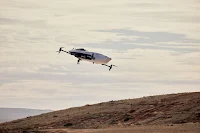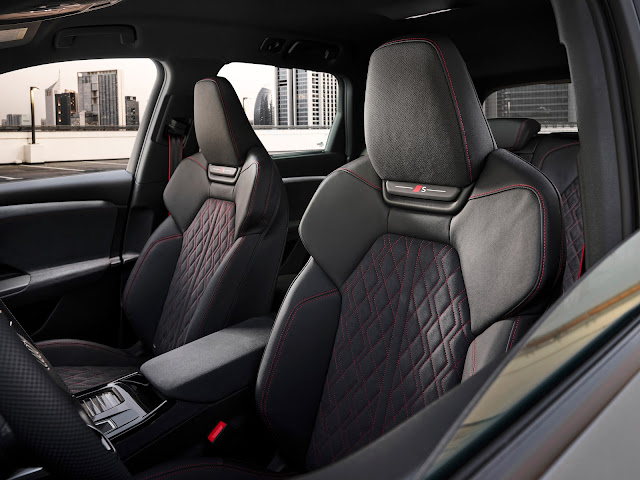World’s first flying racing car makes historic first flights: Airspeeder Alauda Mk3
In the summer of 2019 entrepreneur Matthew Pearson stated his ambition to create the world’s first racing series for electric flying cars. His mission was informed by the role racing historically played in accelerating the development of both ground and air mobility.
Today, Pearson and his team proudly echo the legacies of automotive and aviation pioneers like Enzo Ferrari, Karl Benz, John Alcock and Arthur Brown in making history through the first flights of a full-scale electric flying racing car, the remotely-piloted Alauda Mk3.
These historic first flights have taken place at undisclosed test locations in the deserts of South Australia under the observation of Australia’s Civil Aviation Safety Authority (CASA). Throughout the development process, the Alauda team has worked with the regulator to ensure compliance to all required procedures while developing robust safety protocols. The successful execution of these flights means that uncrewed electric flying car Grand Prixs will take place in 2021 at three soon-to-be-revealed international locations.
These races will see elite pilots drawn from aviation, motorsport and eSports backgrounds to remotely pilot the world’s only racing electric vertical take-off and landing (eVTOL) craft. These pilots will remotely control their Speeders in races across electronically governed , Augmented Reality enabled sky-tracks. Audiences will watch via digital streams that show the full dynamic potential of vehicles that have greater thrust-to-weight ratio than a F15 fighter jet.
These races will rapidly hasten the arrival of eVTOL advanced air mobility craft. This technology, predicted by Morgan Stanley to be worth $1.5 trillion by 2040 is already finding potent applications in air logistics and remote medical care and has the potential to liberate cities from congestion though clean-air passenger applications like air taxis.
By creating the world’s first racing series for electric flying cars, Alauda Aeronautics takes a leadership position in this generation's defining mobility revolution. It does this by providing a place and a space to rapidly accelerate the development of the key safety, performance and dynamics technologies that will underpin the growth of eVTOL transportation.
EXA: AIRSPEEDER’S FIRST ELECTRIC FLYING CAR RACING SERIES
“EXA delivers on the promise of a future first shown in science fiction. We are proud to introduce a sport that redefines what humans and machines can achieve together. These historic first flights are just the start and we are all excited to begin a momentous new chapter in motorpsort’s rich legacy.”
Matthew Pearson, Founder, Airspeeder and Alauda Aeronautics
EXA is Airspeeder’s first racing series. Up to four teams with two remote pilots per team will compete in three individual events across the globe through 2021. They will race ‘blade-to-blade’ over locations inaccessible to traditional motorsport. Audiences will tune-in through global streams available on-demand. This approach reflects the changing requirements of global audiences, in particular a generation native to streaming and the ability to interact directly with the content generators they follow.
A pre-season will soon be announced and will take the form of an internal drag-race style competition between two distinct ‘works teams’ drawn from within Alauda. These final test events will serve as an important technical and strategic shake-down before external teams are invited to prove their competitive edge against the creators of the sport.
The Alauda Aeronautics Mk3 EXA race-craft are remotely piloted by highly skilled women and men. They take a seat in a simulator environment that mimics the dynamics and ergonomics of the Mk3 cockpit environment. From there they control the vehicle in exactly the same way as a pilot located in the cockpit with finger-tip commands sent instantly to the physical Speeder as it plots a series of courses dictated by electronic sky-tracks. Each Alauda Aeronautics Mk3 is presented to teams with identical specification, meaning it is pilot skill and team strategy that will determine race-winners. This will ensure the close competition traditional motorsport fans crave.
Physical tele-robotic avatars named ‘The Aviators’ sit within the cockpit environment of the Mk3. They have been designed to represent the frame of human pilots. This will provide engineers with critical data and information on the effects of high speed racing, rapid turning, acceleration and deceleration on the human frame. This will accelerate Airspeeder’s progression to human piloted races which are scheduled in 2022.
EXA will remain the proving ground for the Airspeeder crewed racing series, providing a vital technical test-bed for teams and the perfect space to develop pilot skills. This means Airspeeder is able to draw its pilots and crew from a wide range of backgrounds including eSports as they can undertake the necessary training on the dynamics of an electric flying race car in a remote environment. In legacy motorsport terms, EXA will take its place as the feeder series for crewed Airspeeder races in the forthcoming Alauda Mk4.
Every Airspeeder race includes rapid pit stops. To facilitate this, Alauda’s engineers have developed an innovative ‘slide and lock’ system for the swift removal and replacement of batteries when on the ground. Intense internal competition between in-house pit-crews has driven the pitstop time down to just 20 seconds, which is entirely comparable with any form of ground-based legacy motorsport. This is expected to continue to fall. For context, a Formula 1 pitstop used to take more than a minute.
THE ALAUDA Mk3 | EXA SPECIFICATION
ENGINEERED BY INDUSTRY LEADERS:
“The Alauda Aeronautics Mk3 is the world’s first performance eVTOL craft. It is the result of the very best minds working with focus to accelerate a mobility revolution. Racing will take this a step further and we cannot wait to compete with elite teams to show the world the dynamic potential of these incredible performance race-craft.”
Matthew Pearson, Founder, Airspeeder and Alauda Aeronautics
To execute the creation of an entirely new classification of advanced aircraft, Pearson has gathered a world-class team of technical experts, engineers and designers from F1, performance automotive and civil and military aviation backgrounds. This includes: McLaren, Brabham, Boeing, Jaguar and Rolls-Royce.
From Alauda’s technical HQ in Adelaide, South Australia, a globally recognised centre of excellence in aerospace and space technology, they have successfully engineered and tested the world’s first flying electric racing car, the Alauda Airspeeder Mk3. It has now entered production, with 10 in build ready for the teams that will take place in the EXA Series races.
Airspeeder is also a global operation with a commercial HQ based in London. From there, CCO Jack Withinshaw has led a team that has forged partnerships by some of the most globally recognised backers of elite motorsport. This includes: Acronis, EQUALS, DHL and IWC Schaffhausen. The London base, in direct proximity to the leading teams in F1 also acknowledges Britain's place as the home of this new motorsport and a globally recognised hub for rights-holders and sponsors.
DESIGN:
The Alauda Airspeeder Mk3 draws its design inspiration from the classic forms of racing cars from the 1950s and 60s. Indeed, Head of Design, Felix Pierron’s vision melds F1 car dynamics with the profile of a fighter jet and function of helicopter. The result is a performance eVTOL machine that promises to enthuse audiences across the globe in the limitless potential of this defining new advanced-air mobility technology.
PERFORMANCE:
At maximum power the craft delivers 320kW, equalling an Audi SQ7 performance SUV. The Audi weighs 2,500kg while an Airspeeder racing craft (without pilot) weighs just 130kg. It can lift a weight of more than 80kg, proving the viability of the powertrain for piloted races. Acceleration from 0-62mph takes 2.8 seconds and the Speeder can climb to 500 meters.
A Speeder can turn with extraordinary speed when compared to a traditional fixed wing aircraft or helicopter. The Mk3 vehicle has a thrust-to-weight ratio of 3.5, which exceeds that of an F-15E Strike Eagle (thrust-to-weight ratio of 1.2), one of the most advanced fighter aircraft in the world.
The rapid hairpin turning potential achieved through an octocopter format has been compared to that of a Formula 1 car, generating up to 5Gs, with the added capability to manoeuvre vertically.
The engineering team has developed an advanced carbon fibre structure, carrying strength and weight-saving benefits. Indeed, there is an obsession at Alauda with shedding grams to gain critical seconds in performance. A Mk3 consists of a carbon fibre chassis and advanced integrally stiffened skin which allows for the complex shapes of the fuselage while providing structural integrity of the vehicle under extreme racing conditions and manoeuvres.
The vehicle batteries have been re-designed resulting in 90% more capacity with only a 50% increase in weight over the earlier Airspeeder concept vehicle. The design of the battery modules also provides for an exciting strategic layer to the Airspeeder racing events.
Power delivery profiles can be changed by ground-crews to respond to the different requirements of the electronically governed sky-tracks that Airspeeder pilots will follow. For example, a lay-out that demands rapid maneuvers through sharp turns and ascents will require a different power delivery curve from those that demand outright straight-line speed. Ground crews will have to make instant decisions around sacrificing raw power for outright range.
SAFETY:
Airspeeder employs a systems-based approach to safety. This is a recognised methodology from military, civilian and performance aviation. This means that no single operational failure can lead to loss of the primary function of the vehicle, which is controlled flight.
In the early stages of the Mk3’s development numerical simulation, sub-system testing and whole of vehicle system testing methodologies were employed to digitally design these systems and ensure the aircraft was capable of achieving its design objectives. Ahead of the flight testing program, this gave engineers confidence that the overall system safety of the vehicle was such that no one isolated failure could result in the loss of the vehicle, but rather the vehicle will remain in the air, but at reduced performance, to ensure the pilot, whether operating remotely in the case of the Mk3, or in the cockpit in future iterations, will be able to safely return to the ground.
During flights, all systems are monitored on the ground through a state-of-the-art telemetry system. This means that groundcrew are immediately aware of issues and can take appropriate action to bring the craft to ground safely.
Prioritising safety is also inherent to the architecture of the vehicle. The octocopter layout ensures stability in the event of rotor failure or breakage, while the carbon fiber structure of the Speeder has been engineered for overall structural integrity.
The Mk3, which will be operated by an expert remote operator from the ground, features a suite of technologies and engineering elements never before seen on an eVTOL aircraft. These innovations will be validated in this key uncrewed proving phase and include sophisticated collision avoidance systems that create a ‘virtual forcefield’ around the craft to ensure close but ultimately safe racing.
THE STRUCTURE OF A SPORT
Airspeeder and Alauda Aeronautics are truly global operations. The sport’s technical HQ is in Adelaide, South Australia in direct proximity to the perfect testing grounds for a new form of aerial mobility.
The company’s commercial, communications and administrative HQ is in London, England and is led by CCO, Jack Withinshaw. This provides Airspeeder direct proximity to leaders in motor sport, rights management and regulation.
Alauda Aeronautics designs, engineers and builds the racing craft that participate in all Airspeeder racing events.
Airspeeder EXA Series is Airspeeder’s first racing series. It is where remote pilots take control of the world’s first full-scale electric flying cars. It will serve as the technical and pilot proving ground for the world’s first crewed electric flying car races.
Airspeeder is the forthcoming crewed racing series. It will race across the globe in 2022.








Comments
Post a Comment